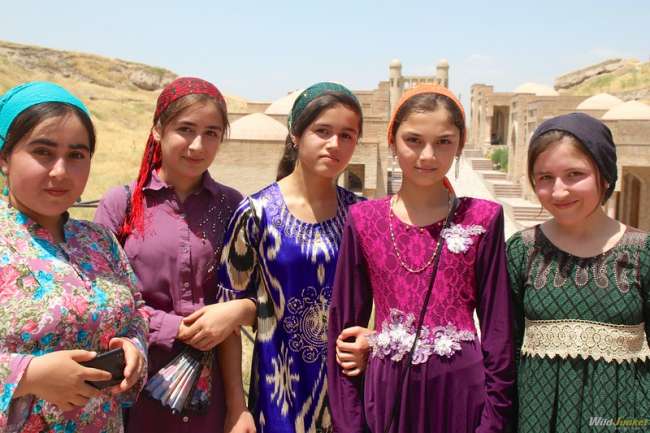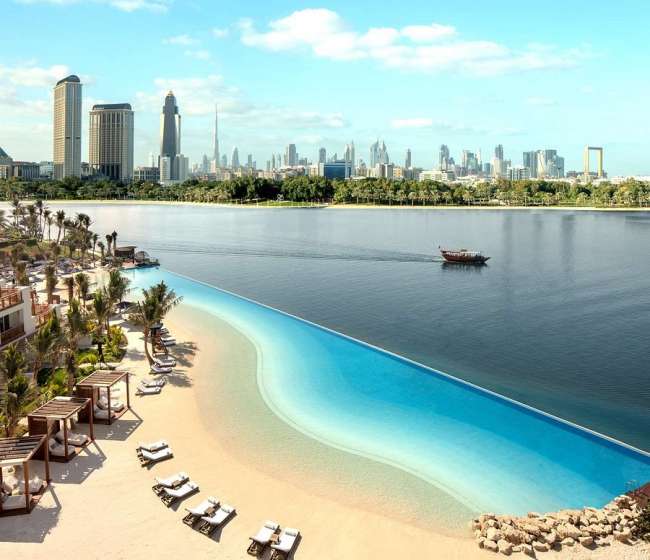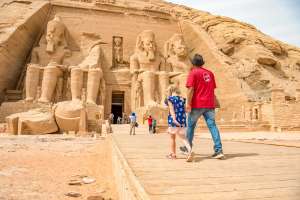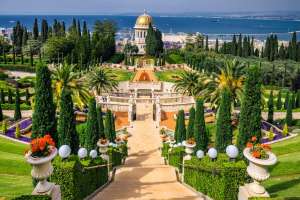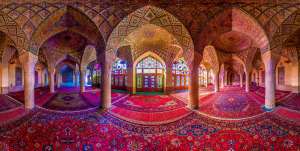Egypt has always been a place that seems to shimmer between worlds — where myth and memory blur together in the golden light of the desert. The very name conjures romance and mystery, echoing with the voices of ancient pharaohs and the hum of modern cities. Few countries on Earth can transport you so quickly through the layers of time. One moment you’re in bustling Cairo, dodging cars and sipping thick coffee in a street café, and a short drive later, you’re standing before monuments that have watched over humanity for millennia.
From the cool blue waves of the Red Sea to the endless dunes of the Sahara, Egypt is more than a destination — it’s a journey through history, architecture, and culture that still defines much of the world’s fascination with antiquity. Whether you’re an adventurer eager to explore ruins, a diver chasing coral reefs, or a traveler seeking the quiet rhythm of the Nile, Egypt offers something timeless to everyone.

Home to the grand tombs of the pharaohs and breathtaking temples carved from stone, Egypt continues to dazzle with its blend of history and natural beauty. Beyond its monuments, the country offers golden beaches, mysterious deserts, and the eternal Nile — a river that has nurtured civilizations since time began.
Beach lovers find their paradise along the Sinai Peninsula, while archaeology enthusiasts lose themselves in the wonders of Luxor. Cairo, vibrant and chaotic, captures the essence of modern Egypt, while Aswan and Siwa offer peaceful respites wrapped in warm desert air.
This land invites you to mix exploration with relaxation — from temple-hopping and desert safaris to cruising down the Nile or diving among coral reefs. Here are fifteen of the best places to visit, each revealing a different face of this extraordinary country.
1. Pyramids of Giza

Standing proud on the western edge of Cairo, the Pyramids of Giza are the last surviving wonder of the ancient world and perhaps the most recognizable symbol of human achievement. These monumental tombs were built to honor the mighty pharaohs Khufu, Khafre, and Menkaure — rulers whose ambition reshaped the desert itself.
Constructed more than four thousand years ago, the pyramids remain a mystery to historians and engineers alike. Theories abound about their creation — from vast ramps to ingenious pulley systems — but no one knows exactly how such precision and scale were achieved with the tools of the time. Guarded by the timeless Great Sphinx, the Giza Plateau feels less like a tourist site and more like a doorway into eternity.
For centuries, travelers have stood here in awe, tracing the golden edges of the limestone in the sun and wondering how human hands could have built something so enduring. Even today, these colossal monuments continue to defy time, reminding the world of Egypt’s eternal grandeur.
2. Luxor’s Karnak Temple and the Valley of the Kings

In southern Egypt lies Luxor, once known as Thebes, the magnificent capital of the New Kingdom. This city is an open-air museum — every stone seems to whisper stories from the age of pharaohs. On the east bank of the Nile, you’ll find the sprawling Karnak Temple, a vast complex dedicated to Amun-Ra, the sun god. Its towering columns, intricate carvings, and colossal statues create a forest of stone unlike anything else in the world.
Across the river, on the west bank, lies the Valley of the Kings, the burial ground of Egypt’s most powerful rulers. Beneath the cliffs are more than sixty tombs, their walls painted with scenes that describe the soul’s journey to the afterlife. The most famous, of course, belongs to Tutankhamun, discovered almost intact in 1922. Nearby, the Temple of Hatshepsut, built for Egypt’s legendary female pharaoh, rises elegantly against the cliffs in tiered perfection.
Luxor is a place where history feels tangible. As you wander its temples at sunset or sail the Nile between its banks, it’s easy to imagine priests, artisans, and kings moving through these same spaces thousands of years ago.
3. Islamic Cairo

The Islamic quarter of Cairo is a living labyrinth of faith, art, and history. Its narrow streets pulse with the energy of daily life while preserving architecture that stretches back over a thousand years. Domes, minarets, and ornate gates fill the skyline, each telling a story from the Fatimid, Ayyubid, and Mamluk eras.
At the heart of this district lies Khan el-Khalili, Cairo’s most famous bazaar — a maze of cobblestone lanes where merchants sell brass lamps, colorful textiles, and spices whose scent lingers in the air. Artisans hammer metal in dimly lit workshops, their techniques unchanged for centuries. Nearby stand magnificent structures like Al-Azhar Mosque, one of the world’s oldest universities, and the imposing Sultan Hassan Mosque, renowned for its immense scale and harmony of design.
For a breathtaking panorama of the old city, climb the medieval gate of Bab Zuweila and watch the sun set over a sea of minarets. In Islamic Cairo, time folds in on itself — each turn of the street revealing another layer of Egypt’s long, evolving identity.
4. Aswan

Resting gracefully along a bend in the Nile, Aswan exudes a calm unlike any other Egyptian city. With golden dunes rising in the distance and feluccas drifting lazily along the water, this southern jewel feels both ancient and timeless. Once a vital trade post for caravans entering Nubia, Aswan still carries that sense of crossroads — where desert meets river, and tradition meets tranquility.
Visitors can cross the river to Elephantine Island, where colorful Nubian villages line narrow paths, or take a camel ride through the dunes to the ancient Monastery of St. Simeon, its weathered stones overlooking the vast desert horizon. The Nubian Museum showcases the culture and artistry of this remarkable region, while a simple tea by the river captures the rhythm of daily life better than any monument could.
Aswan is not a place you rush through — it’s one to breathe in slowly. It invites you to pause, sip mint tea, and watch the sails move silently against the wind as the Nile glows with the colors of sunset.
5. Abu Simbel

In the far south of Egypt, carved into a mountainside near the Sudanese border, stands the awe-inspiring Temple of Abu Simbel. Built by Ramses II, one of Egypt’s most powerful pharaohs, it was designed to project his might across his empire and into eternity. Four colossal statues of Ramses guard the entrance, each standing over sixty feet tall, gazing out across the desert as if daring time to erase them.
Inside, the temple walls are covered in reliefs celebrating the pharaoh’s victories and his divine connection to the gods. Yet the story of Abu Simbel is not just ancient — it’s modern too. In the 1960s, the construction of the Aswan High Dam threatened to submerge this wonder beneath the Nile. In a massive UNESCO-led operation, engineers carefully cut the entire temple into blocks and reassembled it piece by piece on higher ground, preserving it for future generations.
Today, Abu Simbel remains one of the most moving sights in Egypt — a breathtaking combination of ancient artistry and modern preservation that continues to inspire awe in everyone who stands before its monumental gates.
6. Egyptian Museum

Cairo’s Egyptian Museum is a treasure chest of human history — a place so filled with relics that it almost defies comprehension. Behind its faded pink façade lies one of the world’s most extraordinary collections of artifacts from the age of the pharaohs. Every corridor, every cabinet, seems to hold something that once belonged to a king, a queen, or a civilization that reshaped the course of time.
Inside, visitors can trace thousands of years of history: from the delicate jewelry of noblewomen to colossal statues of Ramses II, and from intricate hieroglyphic tablets to everyday items found in tombs. The famous gold mask of Tutankhamun, which once covered the face of the boy-king, remains the museum’s crown jewel, radiating a sense of immortality that words can barely capture.
Though its layout may feel haphazard and its labels few, that very disorder gives it charm — as though you’ve stumbled upon the storeroom of an ancient world waiting to be rediscovered. Every step inside the Egyptian Museum is a journey through centuries of artistry, mystery, and devotion.
7. White Desert

Deep within Egypt’s Western Desert lies a surreal wonderland known as the White Desert, where nature has sculpted art from silence and stone. Vast chalk formations, shaped by millennia of wind erosion, rise from the sand like frozen waves, giant mushrooms, and ghostly creatures. In the sunlight, the terrain glows blindingly white; at dusk, it blushes gold and pink before turning silver under the moon.
Travelers who venture here find themselves surrounded by an otherworldly stillness. There are no crowds, no sounds except the whisper of the wind. Camping under the desert’s night sky — with stars scattered like diamonds overhead — is one of the most unforgettable experiences Egypt can offer.
This place feels both alien and sacred, a natural sculpture park crafted not by human hands but by time itself. It’s a reminder that Egypt’s magic isn’t confined to temples and tombs — sometimes it’s found in the quiet beauty of the earth.
8. Siwa Oasis

Hidden deep in the Western Desert, near the Libyan border, the Siwa Oasis is a world apart. Its emerald palm groves and shimmering salt lakes form a stark contrast to the golden dunes that surround it. For centuries, Siwa was isolated from the rest of Egypt, preserving a unique culture, language, and rhythm of life unlike anywhere else.
The town’s centerpiece is the Shali Fortress, a sprawling ruin made of sun-dried mud brick that rises dramatically above the oasis. Around it, cool freshwater springs — like the famed Cleopatra’s Bath — invite travelers to rest and refresh under the desert sun. Siwa is also known for its traditional crafts, particularly handwoven fabrics and silver jewelry that echo ancient Berber designs.
Evenings here are peaceful and poetic — the air filled with the scent of dates, the sound of distant music, and the slow hush of desert winds. For anyone seeking solitude and authenticity, Siwa is one of Egypt’s most enchanting escapes.
9. Alexandria

Few cities in the world carry such a mix of legend and nostalgia as Alexandria. Founded by Alexander the Great in 331 B.C., it was once the cultural heart of the Mediterranean — home to the Great Library, the Lighthouse of Pharos, and the brilliance of scholars like Euclid and Hypatia. Though much of its ancient splendor has vanished, the city still hums with echoes of its glorious past.
Today’s Alexandria is an elegant blend of history and sea breeze. Locals stroll along the Corniche, sipping coffee in vintage cafés overlooking the waves. The Bibliotheca Alexandrina, a modern architectural masterpiece, stands as a tribute to the lost library and Egypt’s enduring thirst for knowledge. In the old quarters, faded European façades tell stories of colonial times, while the markets pulse with the colors and sounds of modern Egyptian life.
Alexandria is less about monuments and more about atmosphere — a place that invites you to wander, to listen, and to feel the heartbeat of centuries beneath its streets.
10. St. Catherine’s Monastery

At the foot of Mount Sinai, where tradition says Moses received the Ten Commandments, stands St. Catherine’s Monastery, one of the oldest continuously operating Christian monasteries in the world. Built in the 6th century by order of Emperor Justinian, this stone fortress shelters a priceless collection of manuscripts, religious icons, and artifacts that span two millennia.
Pilgrims and travelers alike come here not only for faith but for awe. Within its walls lies the Burning Bush, said to be the very one from the biblical account. The monastery’s ancient chapel glows with golden mosaics, while its peaceful courtyard offers a sense of timeless serenity.
Most visitors pair their trip with a hike up Mount Sinai, climbing either the gentle camel path or the steep Steps of Repentance carved into the mountain. Watching the sunrise from the summit, with the desert below still cloaked in shadow, feels like witnessing creation itself — a moment of quiet transcendence in the stillness of dawn.
11. South Sinai

The South Sinai region is Egypt’s playground of sun and sea — a paradise for divers, adventurers, and anyone who loves the open horizon. The resort city of Sharm el-Sheikh offers every comfort imaginable, from luxury hotels to lively nightlife, while Dahab attracts travelers seeking a more laid-back, bohemian vibe, where desert meets reef and time slows to a gentle rhythm.
Between Nuweiba and Taba, rustic beach camps made of bamboo huts dot the shoreline, perfect for those craving solitude and simplicity. But above all, South Sinai is world-famous for its diving. The Red Sea hosts some of the planet’s most vibrant coral reefs, teeming with marine life and shipwrecks frozen in time. Whether you’re snorkeling in shallow lagoons or diving deep into the legendary Blue Hole, this region delivers underwater wonders beyond imagination.
Here, the desert’s silence meets the ocean’s song — a contrast that defines the spirit of Sinai itself.
12. Abydos Temple

Far from the crowded tourist trails lies Abydos, a quiet town whose unassuming landscape hides one of ancient Egypt’s greatest artistic treasures — the Temple of Seti I, dedicated to the god Osiris. Stepping into this temple feels like entering a forgotten dream. The air is still, and the hieroglyphs carved into the walls are so sharply preserved that they seem almost new.
The temple’s interior is a masterpiece of color and craftsmanship. Intricate reliefs depict gods, rituals, and royal offerings, their pigments miraculously surviving thousands of years. Abydos was considered the spiritual heart of ancient Egypt — a sacred site where the soul of Osiris was believed to rest. Because of that, countless pharaohs built monuments here, hoping to connect their legacy with the god of the afterlife.
What makes Abydos so special today is its serenity. Unlike Luxor’s bustling crowds, this temple invites quiet contemplation. You can walk through vast stone halls and gaze up at columns covered in divine imagery, feeling as though you’ve slipped through a portal in time.
13. Thistlegorm Dive Site

Beneath the turquoise waters of the Red Sea lies a hidden museum of history — the SS Thistlegorm, one of the most legendary wreck dives in the world. This British cargo ship, sunk by German bombers in 1941 while carrying military supplies to Allied forces, now rests peacefully on the seabed, transformed into a ghostly underwater time capsule.
Divers who explore its remains find an astonishing world frozen in time: trucks, motorbikes, rifles, and even locomotives, all preserved by salt and silence. Coral reefs now bloom across the wreckage, turning a relic of war into a living ecosystem. Schools of fish dart through the ship’s corridors while shafts of sunlight pierce the blue depths, illuminating the cargo decks below.
Trips to the Thistlegorm are organized from Sharm el-Sheikh and Hurghada, and even seasoned divers describe it as an experience that transcends adventure — a blend of history, mystery, and beauty found beneath the waves.
14. Nile Cruising

To understand Egypt, you must follow the rhythm of the Nile — the river that birthed its civilization and continues to sustain its soul. Cruising along its waters between Luxor and Aswan is like reading the story of Egypt page by page, each temple and village revealing another chapter.
Modern cruise ships glide elegantly down the river, offering travelers comfort while connecting them to ancient history. Along the way, passengers can stop at the Temple of Kom Ombo, dedicated to the twin gods Sobek and Horus, and the Temple of Edfu, one of the best-preserved sanctuaries in all of Egypt. As the sun dips behind the desert hills, its reflection turning the river gold, the sense of timelessness is almost overwhelming.
For a more intimate journey, traditional feluccas — sailboats with tall white masts — offer a slower, more meditative passage. Sailing in silence, with only the wind for company, gives you a glimpse of Egypt as it was centuries ago. Whether luxurious or simple, a Nile cruise is less a trip and more an experience of connection — between land, water, and the eternal flow of time.
15. Saqqara

Just a short drive from Cairo, the ancient necropolis of Saqqara stretches across the desert, its sands hiding layers of history even older than the Pyramids of Giza. This was Egypt’s original royal burial ground, and it’s here that architecture took a revolutionary leap — from simple mastabas to the earliest pyramids.
At its heart stands the Step Pyramid of Djoser, designed by the legendary architect Imhotep around 2630 B.C. It was the first stone structure of such magnitude ever built, a prototype for the wonders that would follow. Surrounding it are tombs of nobles and courtiers, their walls decorated with scenes of daily life — hunting, farming, feasting — capturing a civilization’s vitality rather than just its mortality.
Exploring Saqqara feels like piecing together the first pages of human architectural history. Each crumbling stone, each corridor carved into rock, marks a step in the evolution of Egyptian art and engineering. It’s quieter and less visited than Giza, yet it holds a sense of discovery that’s just as thrilling — a reminder that Egypt’s story began long before its most famous pyramids.
Egypt is a country where time bends and the past still breathes. From the shimmering dunes of the White Desert to the solemn grandeur of Luxor, from the deep waters of the Red Sea to the eternal calm of the Nile, it offers endless chances to walk among echoes of eternity. Each site tells not only the story of ancient kings and gods but also of the human spirit’s boundless imagination — one that continues to shape, inspire, and enchant travelers from every corner of the world.





